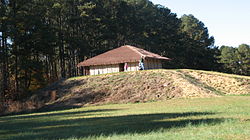17th century
In 1600, the population of Pedee people was estimated to be 600. [18] Europeans, mostly from the British Isles, began settling in South Carolina in large numbers in the 17th and early 18th century. The English established a trading post at Euauenee or Saukey in 1716 to trade with the Pedee and Waccamaw. The Winyah and Cape Fear Indians migrated from the Atlantic Coast up the Pee Dee River to the trading post. [19] [20]
In 1711, the Tuscarora War broke out in North Carolina, [21] and South Carolina tribes joined in the fighting. In 1712, Pedee warriors, along with the Saraw, Saxapahaw, Winyah, and Cape Fear Indians, served in British Captain John Bull's company [20] to fight alongside the British against the Tuscarora and helped defeat them. As a result, most of the Tuscarora left the area and migrated north, reaching present-day New York and Ontario to join the related Haudenosaunee Confederacy of Iroquois tribes. [21]
In 1715, English mapmakers recorded a Pedee village on the west band of the Pee Dee River's central course. [22]
The political relationships formed between the Pedee and other tribes in the area at this time carried over into their alliances of the Yamasee War. The Yamasee War of 1715–1717 resulted in major changes among the Southeastern tribes. Historian William James Rivers wrote in 1885 that the Pedee along with many other tribes were "utterly extirpated." [23] However, some survivors may have found refuge with the Siouan-speaking Catawba, who were located near the South and North Carolina border. [23]
In 1737, the Pedee tribe petitioned South Carolina for a parcel of land to live upon. They, along with their Natchez cousins were moved to a 100-acre (0.40 km2) parcel provided by James Coachman in 1738. [24] This land was in Berkeley County, along the Edisto River. [24]
In the 1740s, the Pedee, along with the Sara, Yuchi, Natchez, and Cape Fear Indians, were known as "settlement Indians," by South Carolinian English settlers. [25] Anthropologists James Mooney and John R. Swanton both wrote that in 1744 the Natchez and Pedee attacked and killed several Catawba people, [19] so the Catawba drove them into European settlements. Mooney wrote of the Pedee that, "In 1746 they and the Sara are mentioned as two small tribes, which had been long incorporated with the Catawba. They were restless under the connection, however, and again Governor Glen had to interfere to prevent their separation." [22] Like neighboring tribes during this era, the Pedee owned African-American slaves. [22]
In 1751, at an intertribal conference in Albany, New York, the Pedee were recorded as being a small tribe living among European colonists. [26] In 1752, Catawba envoys encouraged the Pedee to settle with their tribe. [22] Governor John Glen spoke to Catawba leader King Haigler on May 29, 1755, and said South Carolina had "persuaded the Charraws, Waccamaws, and some of the Pedees to join you [the Catawba]." When Cherokee killed Pedee and Waccamaw people in 1755, they were still living in European settlements. [27] This 1755 mention was the second-to-last historical record of the Pedee people [28] until the 20th century.

